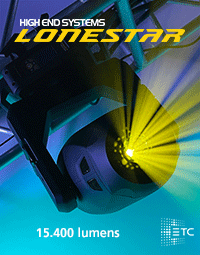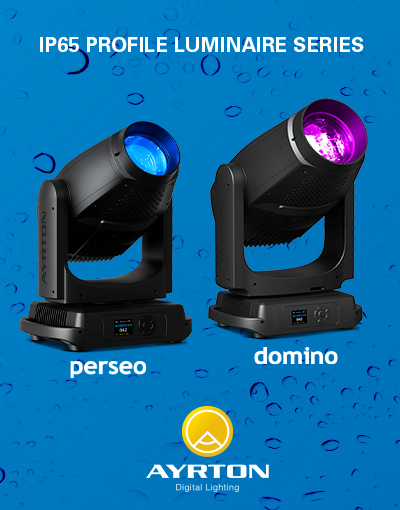This paper is available in Français too
Clay Paky leads its competitors at a cracking pace. Six months after the Super Sharpy was presented at Prolight+Sound, topping the headlines from Plasa is Mythos, a compact spot with a power consumption of only 500 W and an incredible punch, like the Super Sharpy.
Soundlightup was invited to a preview presentation of the Beta version by Clay Paky France before Plasa, and we had time to get out our Minolta lux meter and perform some flux measurements.
This new fixture is part of the new Prima range, along with the LED strobe, Stormy, and Super Sharpy to which Mythos is a natural follow-up.
Mind you that, when we say Beta version, it means that a few points have not yet been finalized and will still evolve before the delivery of the first production models, therefore we will wait for the final production version before publishing our final opinion. We will offer our full review as soon as we are able to examine a production fixture.
Apart from the front lens, Super Sharpy and Mythos are identical and use the same lamp, a 470 W Philips MSD Platinum 20 R. Without a doubt, the first thing one notices about this spot is its ratio of power to luminous output.
The result is stunning! After the first dimmer opening it is a treat for the eyes, literally and figuratively. The beam has a power that one simply does not expect from a spot that consumes less than 500 watts and is only 61 cm tall.
The tests and video
Mythos uses the same movement system as the Super Sharpy. The movements are fast and accurate on both axes. It takes only 1.48 seconds for it to cover 180 degrees on each axis. The management of slow movements can still be improved and Massimo Piccinini, the sales support engineer from Clay Paky who conducted the demonstration, confirmed that the motor controls of the two axes – along with dimmer and color mixing management – was being finalized and would soon be ready and included in a future update.
The color module is particularly ingenious. It consists of three wheels, each made up of two separate sections.
One half of each is used for progressive CMY color mixing filters, while the second half is split into five locations with color filters that the CMY system does not provide: warm, cold and minus green correctors, plus a frost to diffuse the hot spot and a particularly effective UV (Wood) filter.
This solution combines fifteen color filters and CMY color mixing in a minimum space. The choice of color location and color correction that can be added to the CMY system has been carefully designed to minimize any inconvenience that this system could create.
As far as effects go, Clay Paky did not skimp on features. The projector wheel includes 18 fixed gobos. They are directly cut into a disc of metal that can be easily interchanged, as it is held in place magnetically. The rotating gobo wheel has 7 positions. There is also an animation wheel and two rotating and indexed prisms.
Like the color system, the optical system has also been the subject of some particularly ingenious development.
As the two gobo wheels are quite far from each other, they had to find a technical solution to be able to get each into focus.
Clay Paky’s engineers found a solution to this by mounting both the front lens and the zoom lens on the motorized focus carriage. This solution provides a sharp fixed gobo over a range of 6–30° opening and a sharp rotating gobo over a range of 11–50°.
With no gobos inserted, you can obtain a minimum zoom angle of four degrees. As the animation wheel is placed between the two gobo wheels, morphing effects can be easily created.
On paper
Although the projector is a Beta version, with all the risks that implies, we could not resist performing a first set of measurements to confirm our initial impression of a beam on steroids!
With the Mythos’ optical system, this task is not so simple, because you can five different reference beam angles: minimum zoom with focused fixed gobos, minimum zoom with focused rotating gobos, wide zoom with focused fixed gobos, wide zoom with focused rotating gobos and the Beam setting. As the narrow-beam modes for the two different gobo positions are fairly close to one another, we measured the luminous flux for the more narrow of the two zoom angles. We naturally supplemented these measurements with others made at our reference value, an angle of 20°.
Flux measurements – 20° beam angle
It is with the latter that we begin, as a reading at this reference angle can provide us with, simultaneously, a first impression of the luminous output and the uniformity of the beam, and allow us to evaluate the product in comparison to other fixtures.
Our first measurement, at the center of the beam, already holds a big surprise! The meter shows 56,600 lux! An exceptional reading, especially for a 470 W lamp… measurements at every 10 cm along two axes give us a calculated total flux of 23,129 lumens, the lamp being rated for a flux greater than 23,000 lumens, without greater precision. The luminous intensity curve shows a major hot spot. If it is necessary to attenuate this, the first color wheel has a diffuser. The result is nonetheless impressive as, with this luminous output, this fixture can easily hold its own in many rigs and replace a spot with a 700 watt lamp.
The first measurements confirm our first impressions!
Wide beam flux measurements (sharp focus for fixed gobos)
The subsequent measurements are performed at the maximum zoom setting for sharply focused fixed gobos. The illumination at the center is halved: 27,100 lux. On the other hand, with a total flux of 23,347 lumens, we see a more uniform distribution of the light. It is obviously not perfectly uniform, as that is not the whole concept of the fixture, but the luminous decay is much more regular than it is at 20°. We measure an angle of 29.74°, confirming the nominal 30° reported by the manufacturer.
At 30°, the hot spot is attenuated but there is still plenty of luminous flux!
Wide beam flux measurements (sharp focus for rotating gobos)
We then perform another set of measurements at the largest zoom setting that allows for sharp rotating gobos. The difference in the zoom aperture is large, we measured an angle of 46.55°. These results are double-edged. The first result is a significant loss of illuminance. We obtained a total flux of 17,043 lumens, which is quite a disappointing figure, considering the previous results. The second point is more positive. It relates to the hot spot which is much less pronounced at this beam width.
Better distribution of luminous flux but with a sacrifice in intensity!
Tight beam (minimum zoom for sharp fixed gobos)
Thinks start to look better again at the tightest possible zoom setting for focused gobos, and our smiles came back very quickly. At our first reading, the result is through the roof and exceeds the capacity of the meter. We are forced to use a 10X filter to be able to measure the illuminance at the center of the beam: 736,000 lux! The luminous flux reached 27,383 Lumens! Here there is no photo, but plenty of photons! The intensity drops off very quickly: it falls to 1/3 of the center illuminance at the second ring and to 1/5 at the third. At this zoom setting there is an opening angle of 4.87°.
736,000 lux at 470 Watts… need we say more?
The tightest beam (without gobos)
The last session of measurements concerns the tightest beam. This didn’t take us very long, as the illuminance at the center exceeds 1,000,000 lux and, for lack of a 100X filter, it was impossible for us to measure the luminous flux!
Pending
For a pre-production unit, I was very surprised by the results! Mythos is clearly a performer who will combine beam and gobo effects. This is an excellent compromise between a Beam and a Spot fixture. As with all compromises, though, there is room for improvement and, in applications like theater or ballet, it could not replace a moving fixture designed to have a beam that is as uniform as possible. But this was clearly not the goal with this fixture and, except in some specific applications, it will do the job and more.
The ratio of weight, dimensions and power to light output is incredible, and we should soon find this little gem in lighting rigs around the world! We had to bow to the Mythos, but this is not our final word! This break will give us time to acquire a filter and give technicians at Clay Paky time to refine this superb machine! The second round will be coming soon…
Mythos is a great tribute to Pasquale “Paky” Quadri, founder of the Italian company, who recently passed away. Its powerful beam will be our link with his star in the heavens.
.
Text and photos : Stéphane Mocret

























